revised May 13, 2020
A very common question people ask is, "When was my
HP instrument made?" In the early years HP did not put
any kind of date or date code on the instruments. The only
clues to the date of manufacture are certain manufacturing styles
that changed over the years. The color of the paint
may also be a clue as HP used a variety of colors over the
years.
Eventually I hope to prepare a chart of serial numbers to year of
manufacture. It would be of great help to me for everyone
who has a vintage HP instrument to send me an email with the
following information (pictures may be worth a thousand
words):
Model number
Serial number
Logo style
Box style
Binding post style
color of original paint
I will then use this information to compile a data base which I
will post on this web site and refine as new data comes in.
The main focus of this page is dating the vintage oscillators
such as the HP200A, HP200B, HP200C, and HP200D. However,
the information applies to other instruments too.
The early oscillators made between 1939 and circa
1941 could either
have a rounded corner case or a rack-mount case. The
rounded corner case from this period is noticably smaller than the larger rounded corner case in my
collection and has the pilot lamp above the power
switch rather than to the side but the larger rounded corner case
may also have been used. The output binding posts would
have been what I call the original style (I know of a possible
older style but have not been able to confirm that). The
name plate would typically have been metallic without an HP logo. The
labeling on the panel would have been engraved without being
filled with paint. The HP logo was introduced in 1941 so
the presence of that logo indicates a unit made in 1941 or
later. Pre 1941 units did not have a logo. There
was only a name plate with Hewlett Packard on it -- see the
example below.
Oscillators made between circa 1941 and circa
1943 would have the old style rectangular case with
corner brackets. Some oscillators were made with the larger
rounded corner case. The output binding posts would have
been what I call the original style. The name plate would
have been either the metallic for oscillators made in 1941 (and
possibly into 1942 but I doubt it -- more research is needed) or
white non-metallic style (for oscillators made starting circa
1942 -- more research is needed) with the original style of HP
logo. The labeling for the controls would have been printed
on the round mounting plates. The labeling for early units
(circa 1941) would have been engraved on the panel without being
filled with paint.
Oscillators made between circa 1943 and 1945
would have the old style rectangular case with corner brackets. I
know of no examples of a rounded corner case from this or any
later period. The output binding posts would have been the
new #10 binding posts sold by HP. The name plate would
typically have been the non-metallic style with the original
style of HP logo. The labeling for the controls would have
been printed on the round mounting plates.
Oscillators made between 1946 and 1952 would
have been the new style rectangular case with one-piece
corners. The output binding posts were the #10 style.
The name plate was metallic using the revised style of HP
logo. The labeling for the controls was printed on the
round mounting plates.
Here are some crude serial number data I have been able to
acquire. As best I can determine, serial numbers started
with 1 and ran consecutively until the last unit. All
of these oscillators were discontinued in 1952 and the last
serial numbers shown below would be from that year ans also
indicate how many units were made over the years. I will
update this list as I obtain refinements.
HP200A -- last serial number is roughly 31000
HP200B -- last serial number is roughly 46000, first serial
number in 1942 is roughly 2450.
HP200C -- last serial number is roughly 51000 (or maybe
55000)
HP200D -- last serial number is roughly 71000
The pictures below illustrate the various styles discussed
above.

This is an early HP oscillator built around the summer of 1939 and probably hand crafted by Bill. Bill presented it to Stanford University. I took this picture in June of 2006 while touring the HP house and garage and the oscillator was on loan for display in the living room of the HP house.
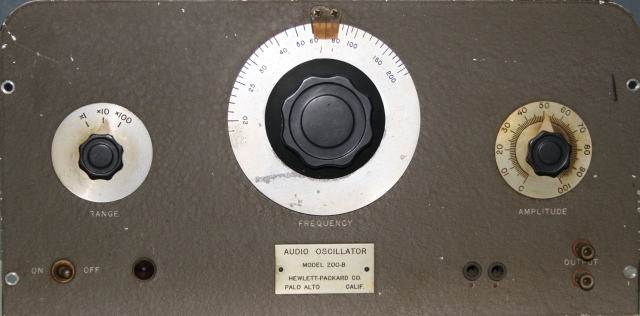
This is a pre-1941 HP200B unit owned by my friend, Glenn (http://www.hparchive.com).
Note that the label does not have the HP logo on it. This
unit has a serial number of 187 and is the oldest unit I know
of. These are very rare.
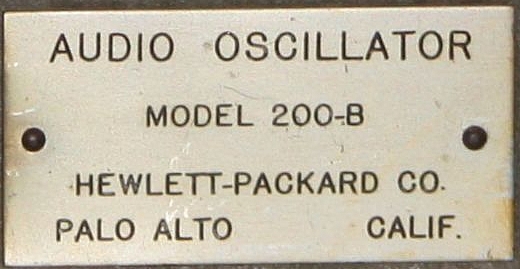
This is a
close-up of the label of the above unit.
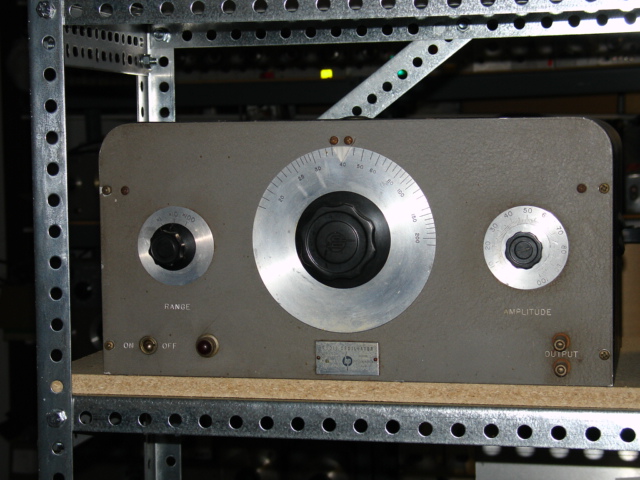
This is an early HP200B with rounded corners. This unit has a serial number of 828 and is believed to have been built in 1941. Note that the panel is engraved without paint fill and it has a metallic model number label and uses the original style of output posts. A close-up of the label is shown below.
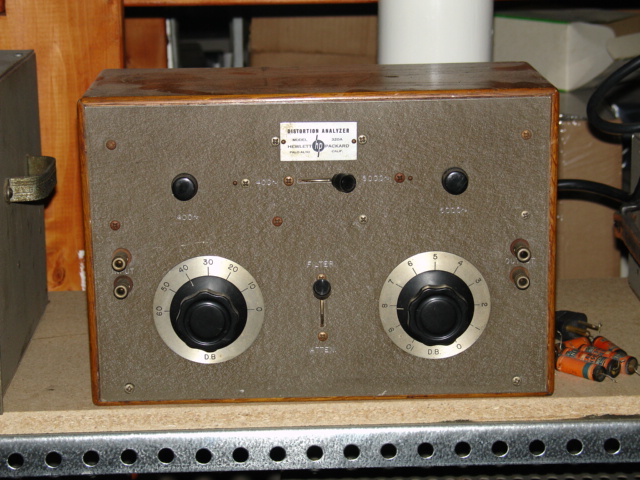
This is an early HP320A distortion analyzer with a non metallic model number label and engraved panel labels and the original style of input/output posts. It is believed to have been made in 1942. It also has a wooden box made of oak. Wooden cases were very common up to the early 1950s. The capacitors to the right were originally part of the unit but all had failed. I wanted to make the unit work so I replaced them with modern capacitors.
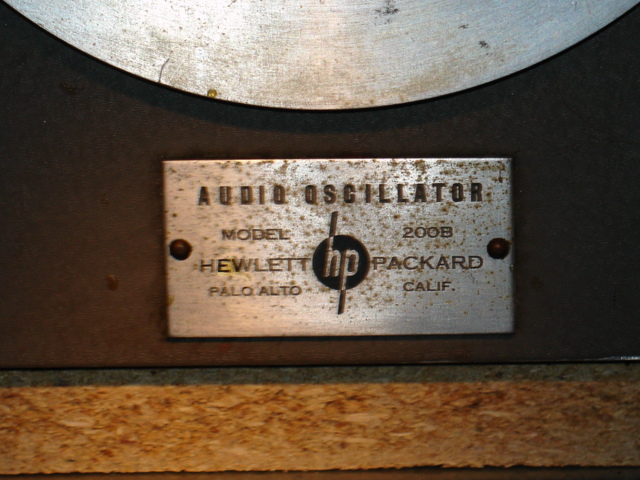
This is the first style of HP logo used on their instruments and
was used between 1941 and 1945. The key feature to note is
the contrasting extensions of the 'h' and 'p'
outside of the circle. The contrasting extensions would be
changed to non-contrasting in 1946 to simplify engraving. I
have seen very few instruments with metallic labels like this
one. It is believed that this metalic label was only used
in 1941. Although this logo style was only used prior to
1946 (there are some exceptions -- see below) on equipment
labels, the style was continued well into the 1950s on printed
manuals. So when you see this style on a manual that does
not mean the manual is pre-1946. A future web page will
discuss dating of HP manuals.
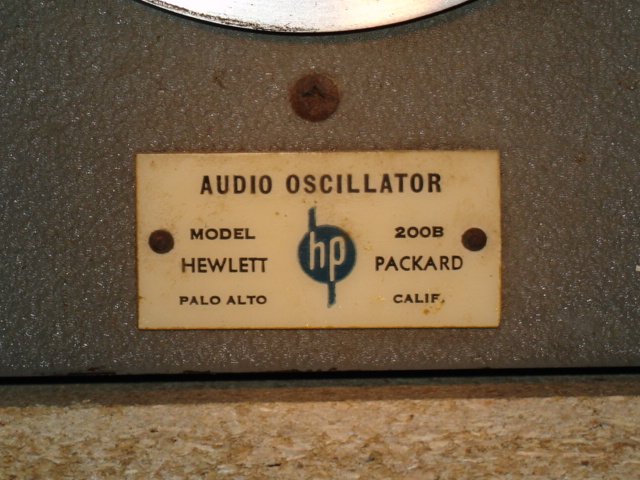
Here is another pre 1946 style of label on one of my oscillators
with the contrasting extensions of the 'h' and
'p'. This is the non-metallic label. I
believe its original color was white but most I see have yellowed
to varying degrees. It is believed that this style of
non-metallic label was introduced in late 1941 or early 1942.
The history section of the HP web site shows a picture of an
HP200C having a serial number of 12 with this identical label
style. The unit would have been made prior to the first HP
logo so something is inconsistent. The unit was cleaned up
prior to being donated to HP and the belief is that the
original label was lost and replaced with a label from a newer
unit.
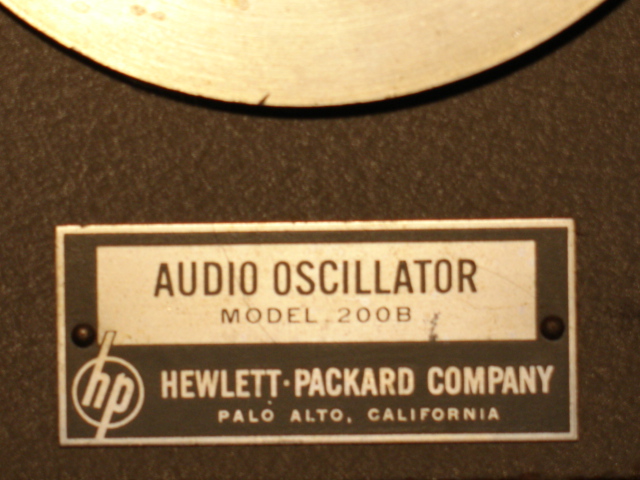
This style of label was adopted in 1946. Note that the
extensions of the 'h' and 'p' no longer contrast
with the rest of the letters. This style was used with
minor variations until 196x.
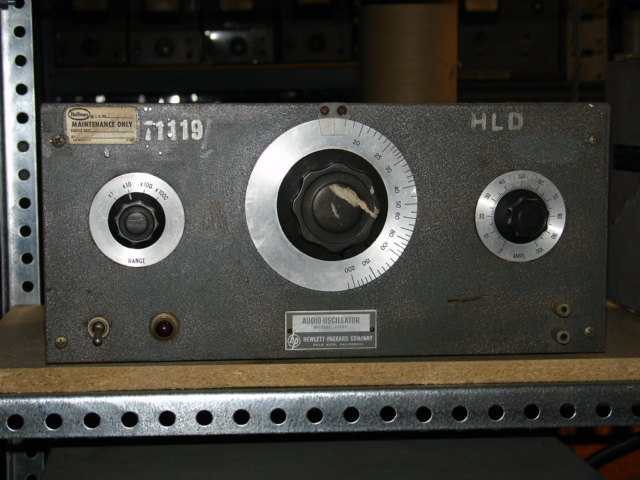
This is an HP200C unit
showing the control labeling on the round plates instead of engraved in the
panel. The frequency knob is not labeled and I have only seen a FREQUENCY
label on pre 1941 units.
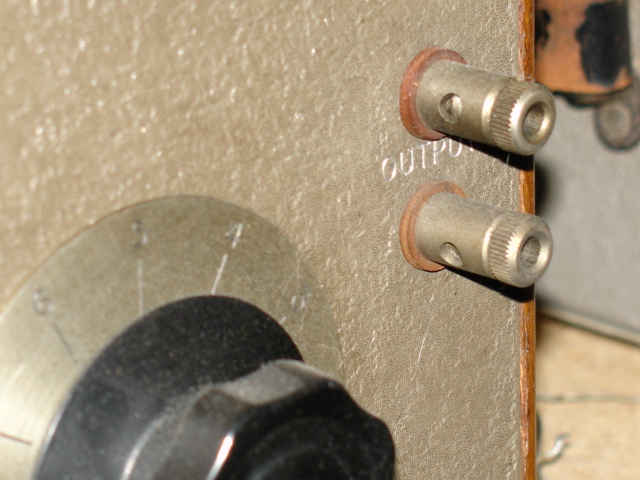
This is a very old instrument that uses what I refer to as the
original binding posts. This style was used from 1939
to circa 1943 and was replaced by the #10 binding posts
which first appeared in the 1945 catalog. Another
indication that this is a very old instrument is the fact that
the labeling was engraved in the panel and was not paint
filled.
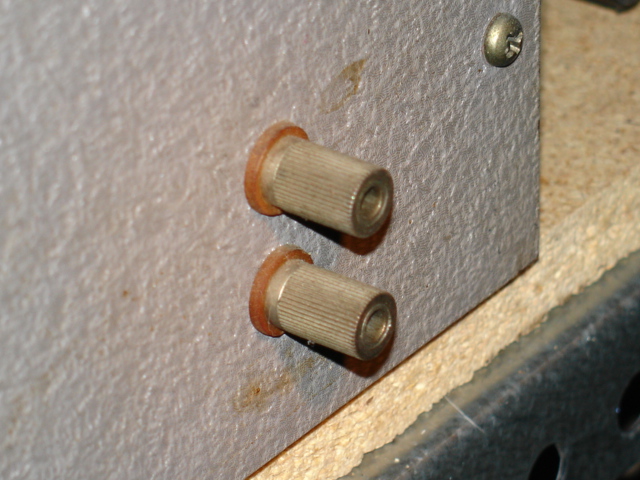
This is an example of the #10 binding posts which I believe were
introduced circa 1943. The knurled body nut could completely
unscrew from the jack and these often became lost. Thus, it
is not uncommon to see equipment from this period with the
binding posts replaced by more modern plastic ones.
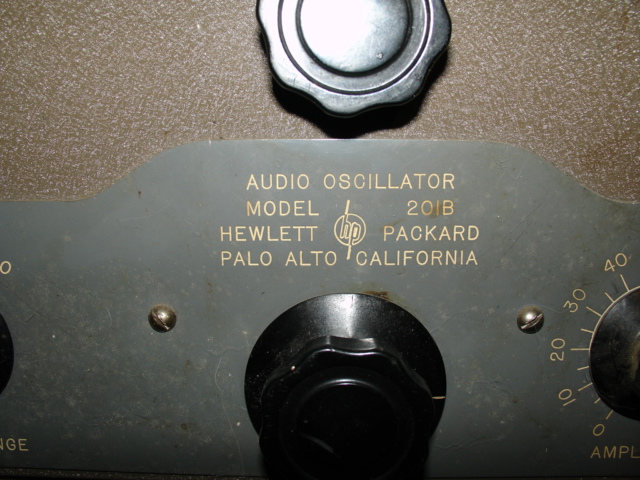
Here is an example of the pre 1946 logo that was engraved and
paint filled. However, this style is found on instruments
known to be made after 1946. More research is needed.
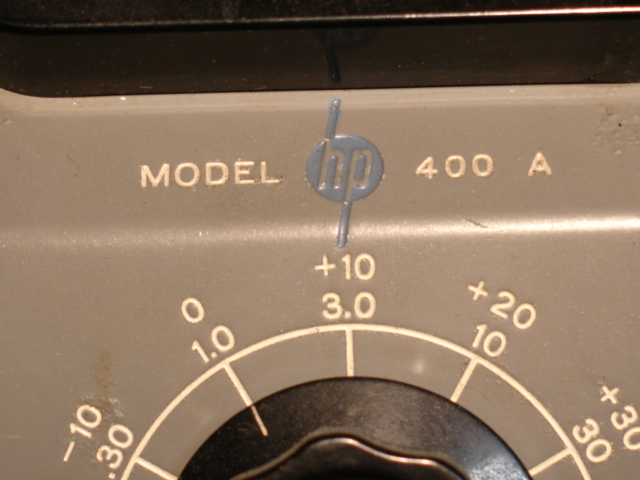
Here is another example of a pre-1946 logo engraved and paint
filled.

Here is a post 1946 label that is engraved and paint filled.
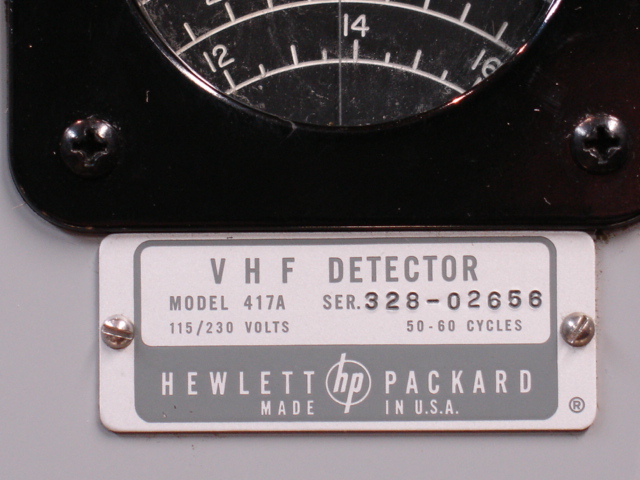
Here is the name plate of an instrument made in the early
1960s. Note that it is very similar to the style introduced
in 1946 but the text has a different font and is spaced for
easier reading. Note also that the original Palo Alto,
California has been replaced by Made in U.S.A. as HP had plants
in different places by this time.

This is the old style rectangular enclosure used in the early
1940s and uses corner brackets.
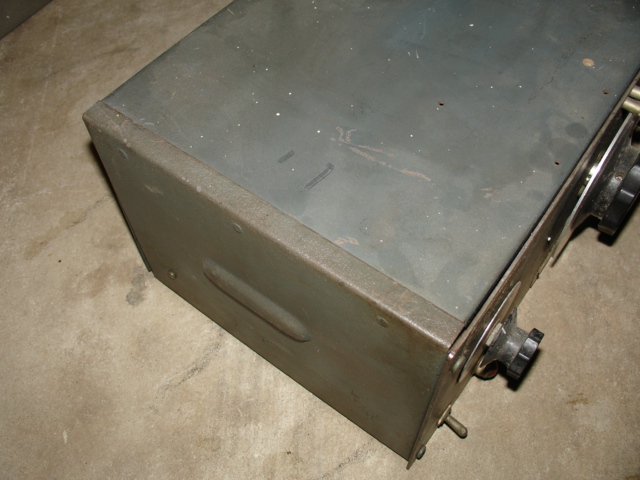
This is the newer style rectangular enclosure used after the mid
1940s and features one-piece corners.
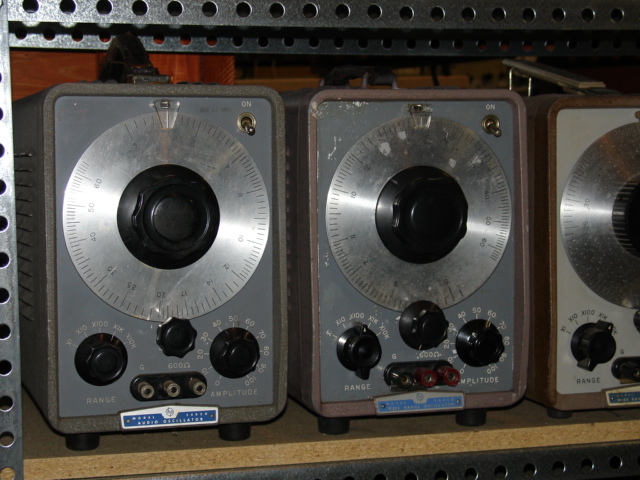
These are two old HP200CD units. The one on the left is has a
serial number in the 200 range and most likely comes from the
first production run. The first few thousand of these units used
the #10A binding posts like on the early 200 series but now
mounted on a plastic plate. The unit on the right is
believe to have been made around 1954. I saw this unit in
pathetic shape at a hamfest and kind of felt sorry for it and
bought it cheap. After a lot of effort and considerable
clean up the unit now works like new. Note that this unit
uses the new #10C and #10D binding posts.
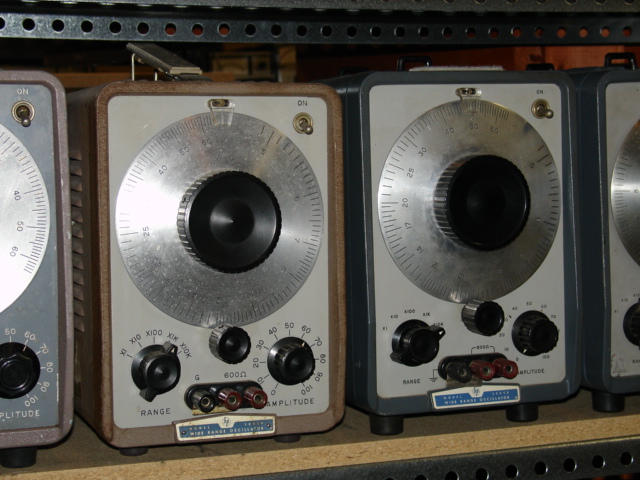
The HP200CD unit on the left is from the late 1950s and the unit
on the right is from the early 1960s
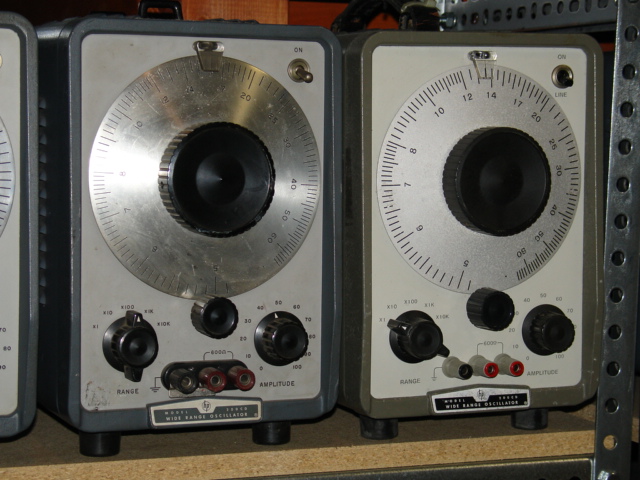
The HP200CD unit on the left is from the late 1960s. The
unit on the right is the last version of the HP200CD and is
believed to have been made in the late 1970s or maybe early
1980s.
More to come ...